This Sourdough Starter is pretty darn easy to do and a great option for delicious homemade baked goods! A sourdough starter doesn’t have to be a chore, and the end result is worth the patience in the beginning. If you like homemade treats try my Sourdough Pretzels!
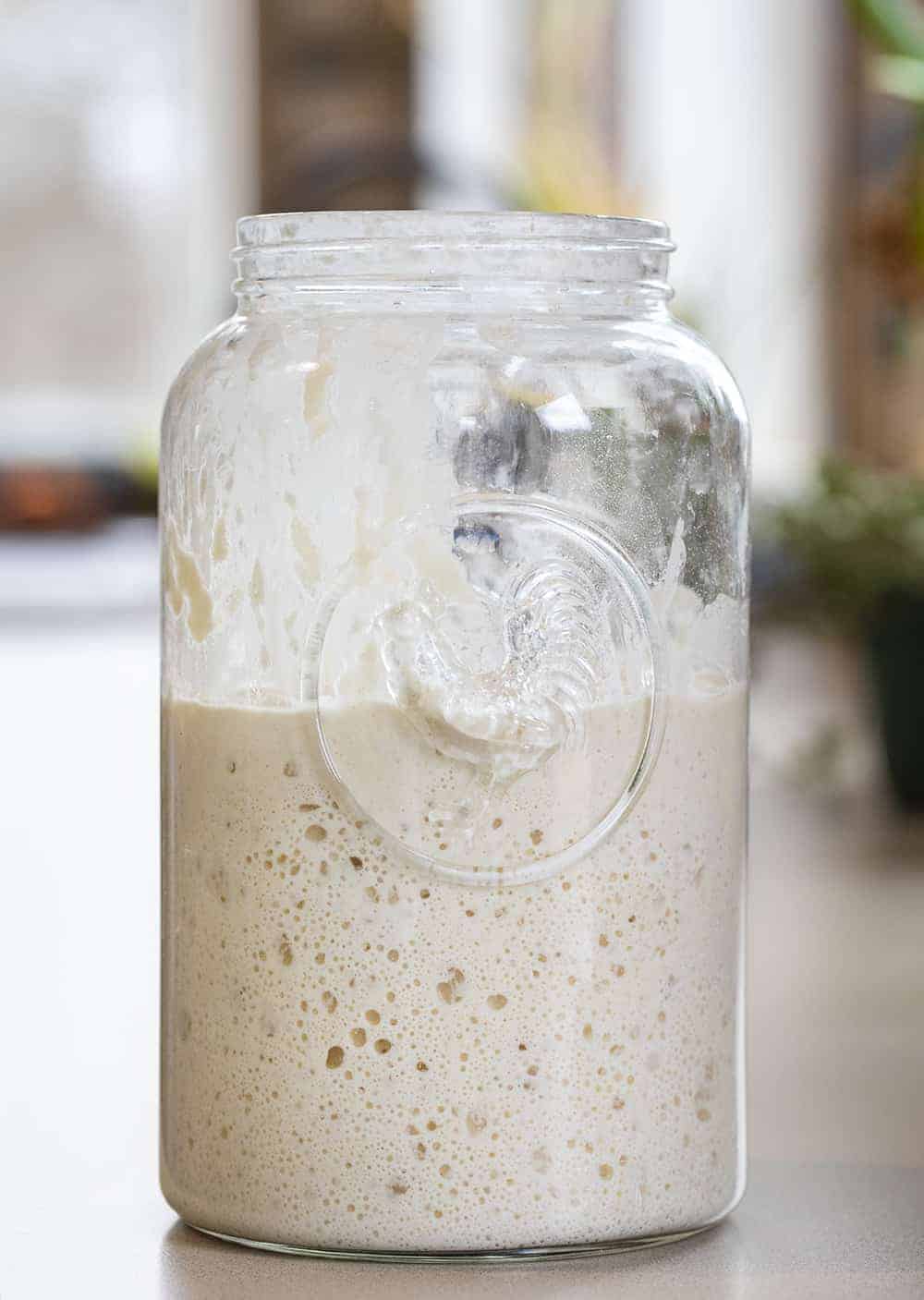
Sourdough Starter
I have to start out by saying that this is how *I* do a starter. I have watched every expert under the sun and read every book and let me tell you something… they are all different. So I have been testing and testing and retesting and using life experience to determine what works best for me. Well, I finally decided on what worked best for me, and it could not be easier and straight forward. The ingredients are simple: flour and water. And, with just two measurements to remember, the feeding is a piece of cake (or should I say bread😉) as well!

Getting your Sourdough Starter Started
Now if you want to bring science into it, the type of flour and type of water you use are important. They can produce a better product. But I am here to tell you that you can absolutely use all-purpose bleached flour from Dollar General and it will still be ok. Make sure you have the following materials and ingredients on hand:
- Jar & Lid – I prefer glass, you don’t want to use metal or plastic. If you don’t have a lid use a paper towel and rubber band. A good size jar to have on hand for a sourdough starter is a quart (32 ounces) or something close to that capacity.
- Flour – I prefer organic unbleached all-purpose, but also love whole-wheat and bread flour. Or, give rye flour a try.
- Water -Purified is best. Have chlorinated tap water (as most people do)? You can use bottled water or just set the water out uncovered for 24 hours before using it to feed your starter. This allows the chlorine to evaporate so it won’t kill the wild yeast.
That’s it for supplies! Now, let’s get to making the starter.
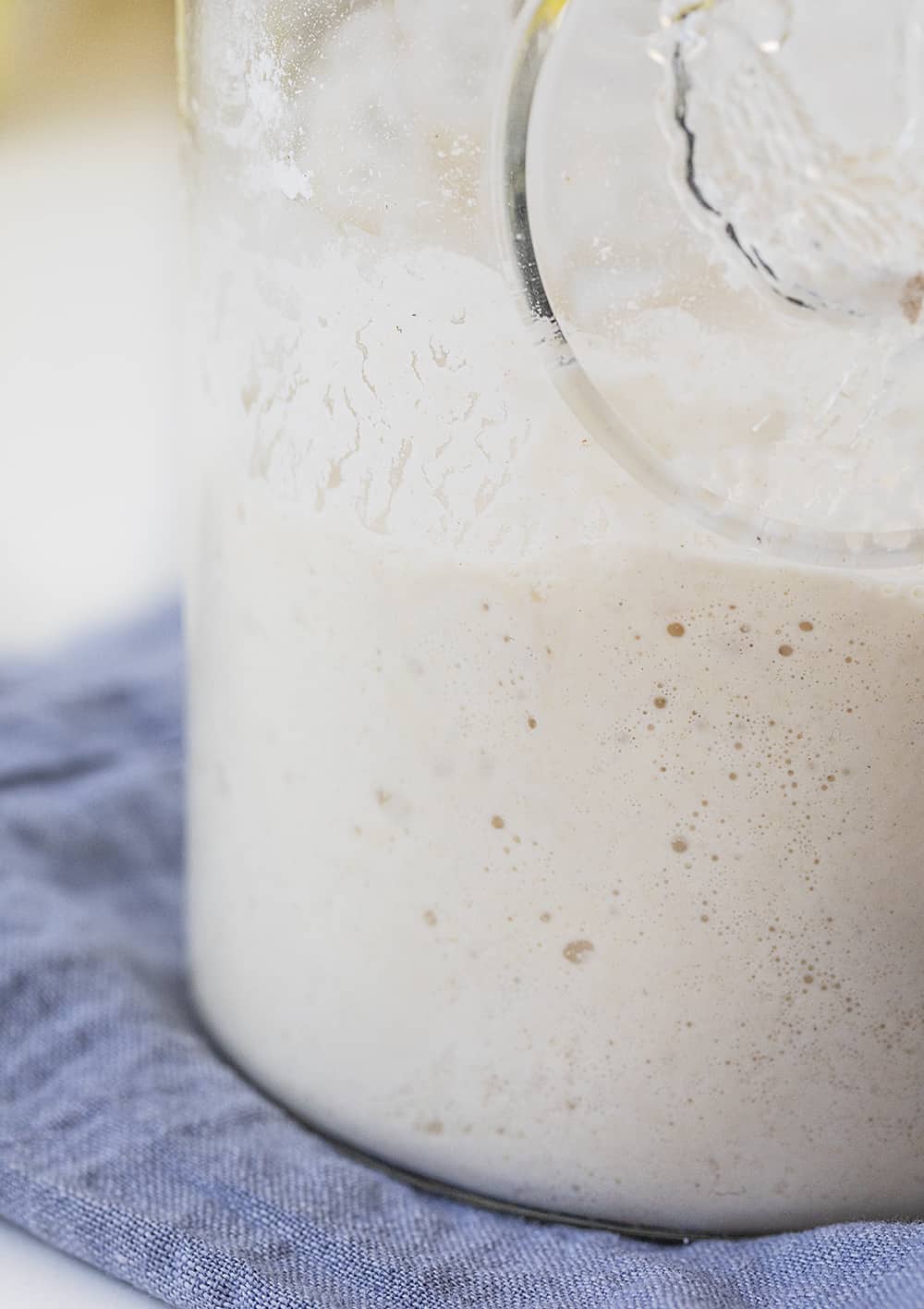
How to Make a Sourdough Starter
Remember these amounts: 1/2 cup flour and 1/4-1/3 cup water. These are the only measurements you will need to remember throughout this entire process of creating your sourdough starter. And trust me, you will use those measurements a lot with all the ‘feeding’, going on! After all, the goal is to get those microorganisms to work for that sour and fermented flavor that sourdough is known for.
To begin, add the flour and water to a jar and stir well. Try not to use a metal spoon. After all, Grandma said she always uses the handle of her wooden spoon to stir. Now gently cover the jar (do not seal it closed) and let it sit in a warm place (70°F is best) for 24 hours. The best option for a cover is a paper towel and rubber band. Or, just remember to keep the jar lid loosely sealed. Try to keep it in an area of your house that is somewhat warm. Very cool rooms tend to slow the action of a starter. Wait 24 hours before checking the mixture.

‘Feeding’ the Sourdough Starter
With sourdough starters, you will hear the term ‘feeding’. This is simply adding the flour and water to the mixture to keep the microorganisms working. Remember the measurements I told you to get ingrained in your brain? The 1/2 cup flour and 1/4-1/3 cup water is all you will need throughout the ‘feeding’ process.
Day 2: After 24 hours, check the mixture for bubbles. If you see bubbles, add the flour and the water, mixing it well, and let it sit for the next 24 hours. If you don’t see bubbles, do not get discouraged! It sometimes takes a couple of days for the science of it all to work. Just wait another day (or even two) until the first feeding.
Day 3: After another 24 hours, check for bubbles. If you do see bubbles, remove half of the starter, add the 1⁄2 cup flour and 1⁄4-1/3 cup water and stir thoroughly. Let sit 24 hours. Oh, and don’t get rid of the starter you removed! I will give you some ideas on how to use this in the end.
For the third feeding, remove half of the starter (but don’t throw it out!), and feed with 1⁄2 cup and 1⁄4 cup water, stirring thoroughly. Let sit 24 hours. (And yes, you can begin a new starter with the discard! Try adding a new kind of four! Or simply use to make crackers or pancakes.)
On days 4, 5, 6 you can feed it 2 times a day with those measurements that are sure to be memorized at this point😀. Continue this routine (discarding before feeding) until the starter is consistently bubbling and doubling in size within 8 hours of each feeding.
It is now ready to use for a perfect Sourdough Bread!
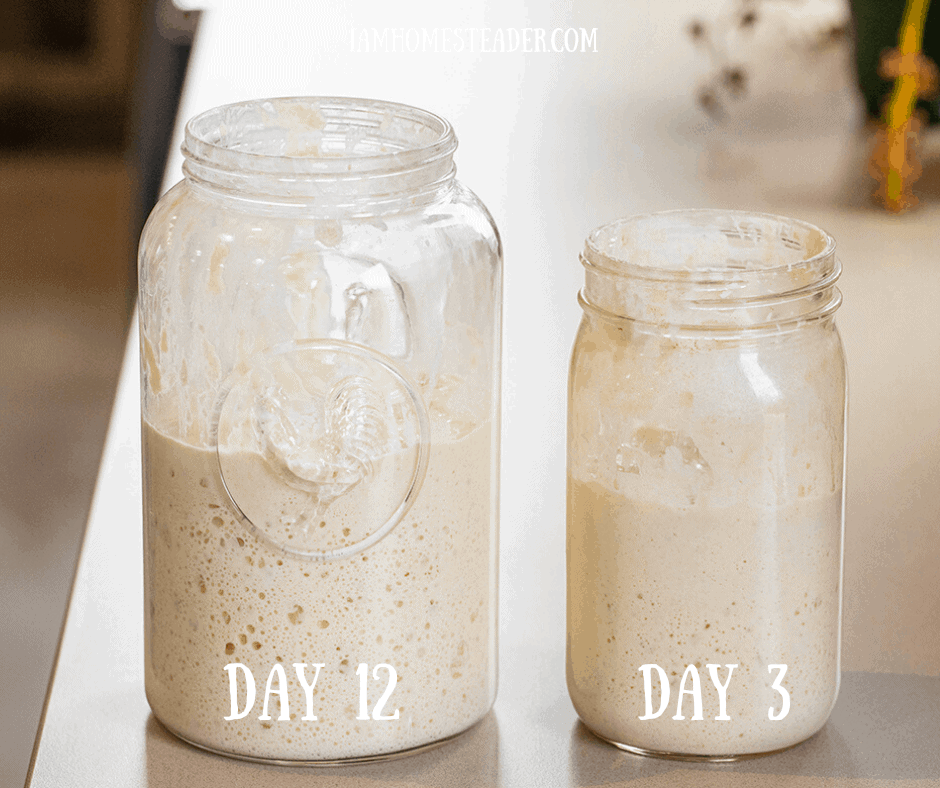
How to Store a Sourdough Starter
After all the feeding and you know you have a strong, active starter, you can store the starter in the refrigerator and feed it about once per week. When you plan to use the starter, pull it out of the refrigerator 24 hours in advance to feed it and allow it to warm up and grow.
These starters get better with age, so don’t think you have to use it right away! Sourdough starters are hearty, so they last quite a while. But, like all living things, it can get ‘sick’ or go bad. If it turns pink, red, moldy, or gets a really putrid smell, throw it out. After all, you now know how to start again!
What Flours Can You Use in a Sourdough Starter?
All grain-based flours will work beautifully in a starter. A few examples are:
- Rye
- Bread Flour
- Rice
- Whole Wheat
- Einkorn
Truesourdough.com has a great comprehensive guide to flours.
Vanilla and Bean has a great guide to Gluten-Free sourdough starter.
What to do with the Discard?
As I said, don’t throw out the sourdough starter that you remove each feeding time to make room for the starter to rise. Just make sure your sourdough starter is room temperature (about 70°F) before using it in baking. Here are some ideas on how to use (and enjoy) the excess sourdough starter.
- Sourdough Bread (not until day 6 or 7)
- Sourdough Pancakes (seriously SO GOOD!)
- Sourdough English Muffins
- Sourdough Brownies
- Sourdough Pretzels
- Cinnamon Rolls (the best!)
- Banana Bread
- Sourdough Crackers (like saltines)
- Sourdough Chocolate Chip Cookies
- Sourdough Pasta Noodles
As I mentioned, this is how *I* make a starter. King Arthur recommends 1 cup flour and 1/2 cup water and they suggest you weigh ingredients with a scale. (This is the same equivalent that I use, just doubled.) Pro Home Cooks has a great free downloadable Sourdough guide for those who really want to understand the science behind it.
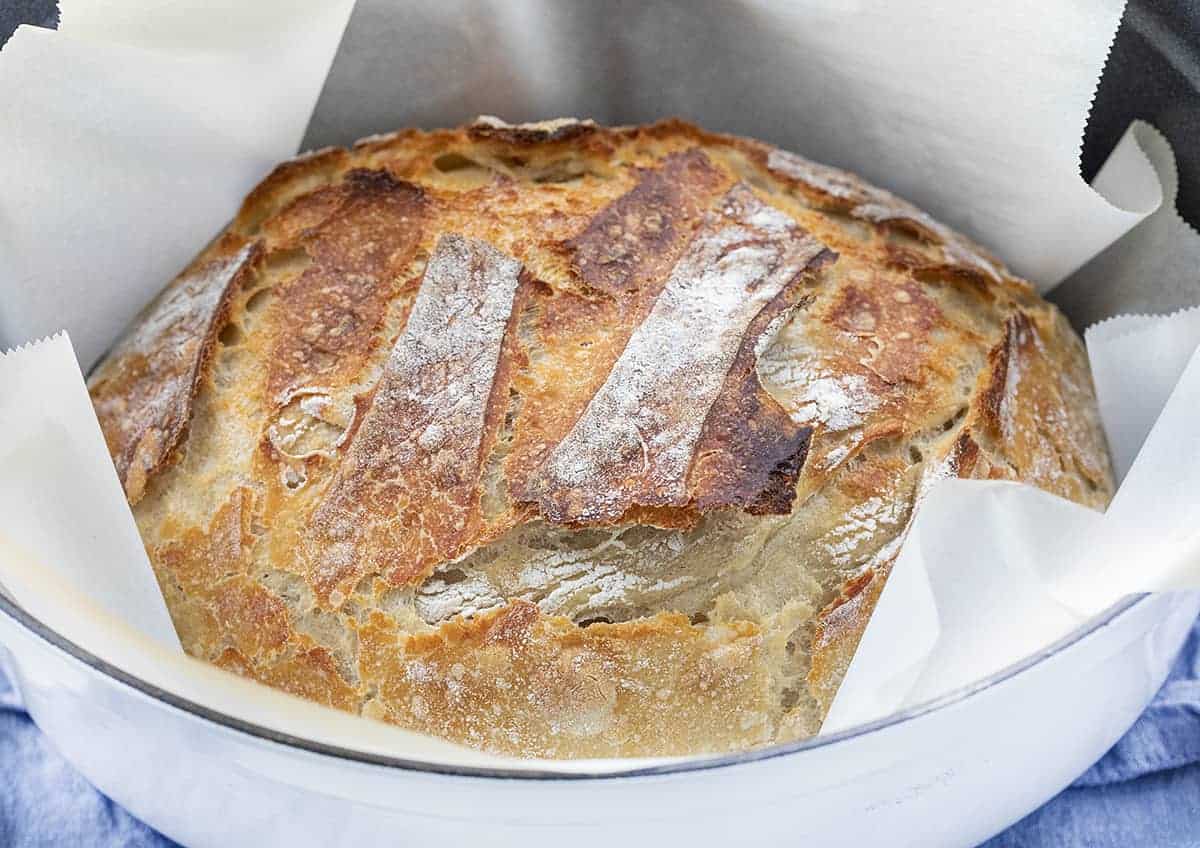
Here is the recipe for Simple Sourdough Bread!
More Sourdough Recipes

Sourdough Starter
Ingredients
- ½ cup flour, whole wheat or unbleached all-purpose
- ¼-⅓ cup water*, 75°F is ideal
- 1 glass jar, or bowl (about 32 ounces)
- 1 paper towel
- 1 rubber band
Instructions
TO BEGIN
- Start the process by adding ½ cup whole wheat flour and ¼ cup water to the jar. (If you need more flour to reach a pancake batter consistency, you can add up to ¼ cup more.)
THE FIRST FEEDING
- Stir thoroughly and cover with a towel and rubber band. Let sit for 24 hours at room temperature. (Try to keep it in an area of your house that is somewhat warm. Very cool rooms tend to slow the action of a starter.)
- After 24 hours, check the mixture for bubbles. If you see some, add ½ cup all-purpose flour and ¼-⅓cup water. If you don’t see bubbles, give it a stir and let sit 24 more hours.
THE SECOND FEEDING
- Check for bubbles again. If you do see bubbles, remove half of the starter, add ½ cup all-purpose flour and ¼-⅓ cup water and stir thoroughly. Let sit 24 hours.
THE THIRD FEEDING
- Remove half of the starter, and feed with ½ cup all-purpose flour and ¼ cup water, stirring thoroughly. Let sit 24 hours.
ADDITIONAL FEEDINGS
- On days 4, 5, 6 you can feed it 2 times a day, if you want and plan on using it.
- Continue this routine until the starter is consistently bubbling and doubling in size within 8 hours of each feeding.
- From this point (or even on day 5), you can store the starter in the refrigerator and feed it about once per week. When you plan to use the starter, pull it out of the refrigerator 24 hours in advance to feed it and allow it to warm up and grow.
Video
Notes
Did you make this recipe?
You can tag me at @iamhomesteader.
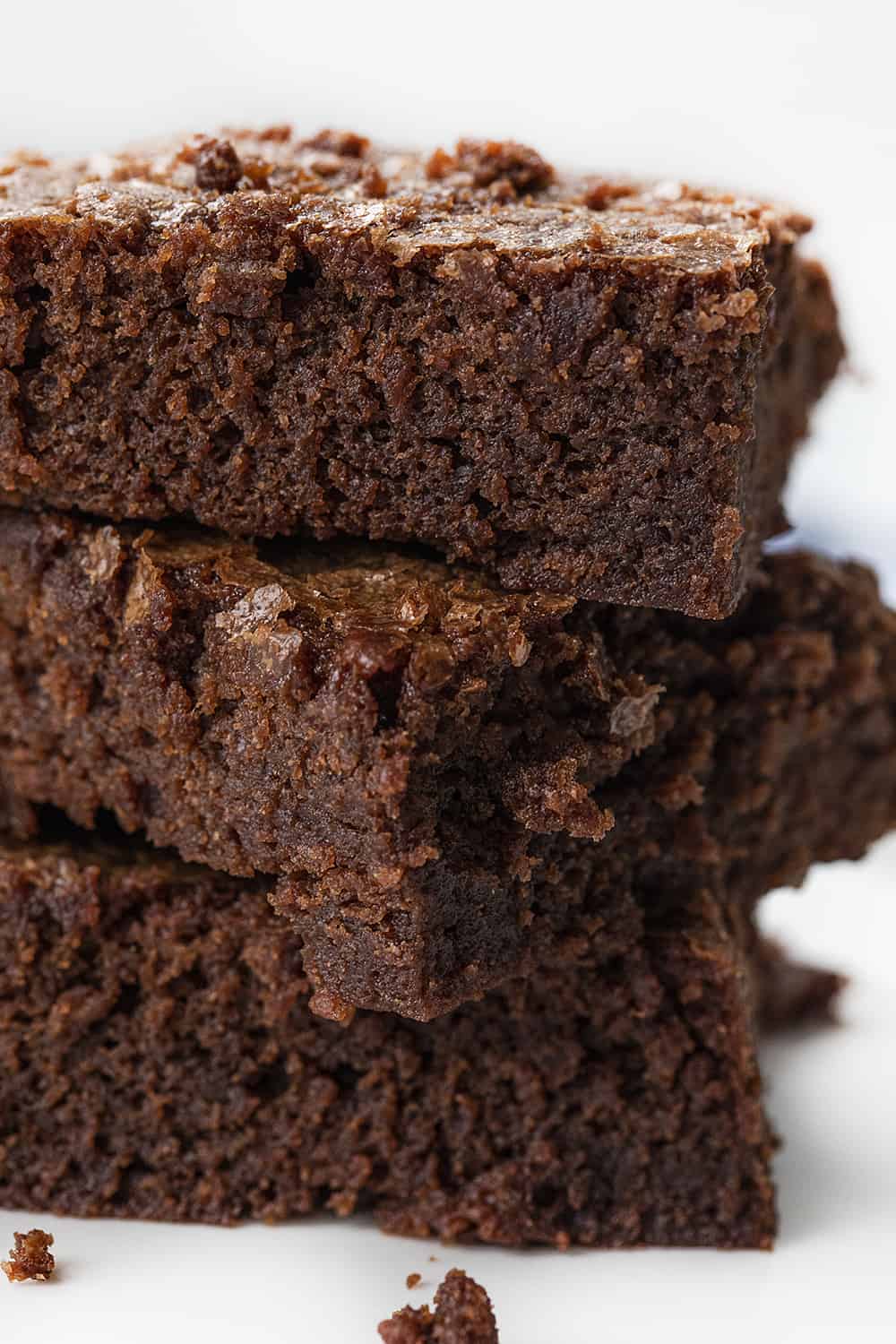
I used this starter to make seriously decadent Chocolate Sourdough Brownies!
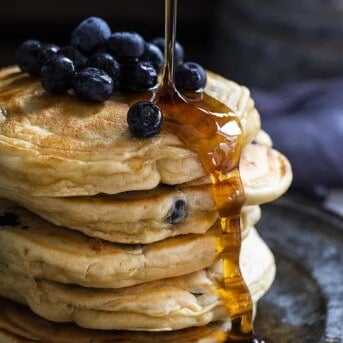
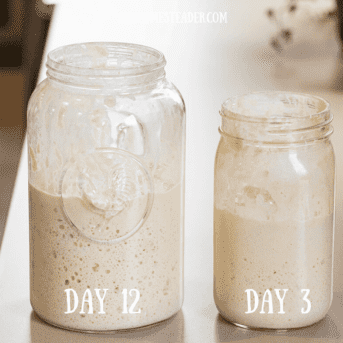
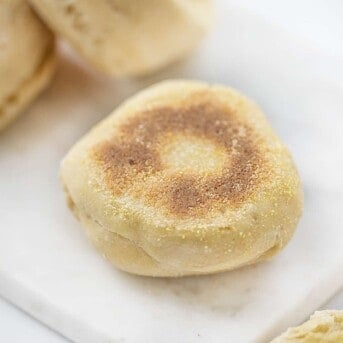
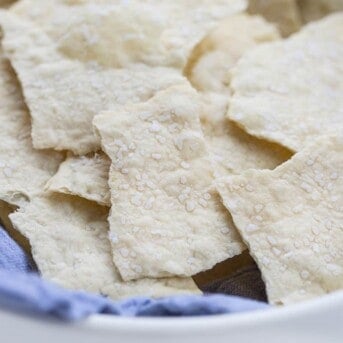


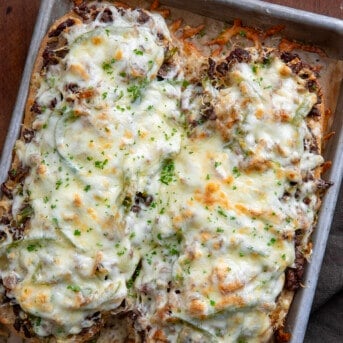
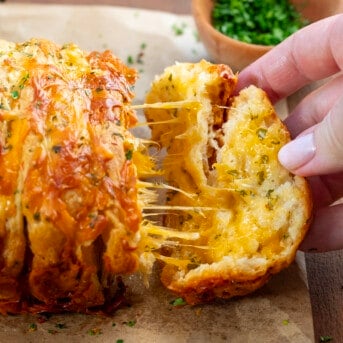
Thanks for this recipe. I’m starting mine today. I’ve never tried it before . I have a question, when I discard half tomorrow, can I put that half in another jar and start a separate starter using that? Hope that makes sense.
Be sure to wait until the 3rd feeding until you discard any… but yes! At that time you can start a new starter or use the discard in recipes. 🙂
Would it be possible once you have established a healthy starter to feed it once every 2 weeks instead of every week? I’m just concerned that I will not be able to bake something every week and I would hate to throw out discard every week that could be used to make something otherwise.
I started your sourdough recipe. I’m on my 3rd day but it has bubbled but today it has a yellowish liquid on top. Do I start over from scratch?
Also where do I go to get your recipes?
Hello, once you use part of the starter, should you feed it, let it grow, then put it in the fridge? Or can you put it in the fridge right after feeding? Thank you
I used white whole wheat flour. I’m on day 2 and it’s bubbling, but it has a grayish marbling through it. Should I start over or keep on with this batch? I wish I could send a picture. It doesn’t smell very good, not like a yeasty smell I thought it would have.
(This is the first time making starter so I can’t really rate the recipe yet.)
Thanks.
It sounds fine. You can either drain off excess liquid and try to remove grey parts or you can simply stir it in. The next time you feed it, consider adding a little LESS water than called for.
I was gifted your sourdough starter. I fed it and made your banana bread and added carob chips. It was delicious! I had some questions but I read every question posted and believe I intuitively found the answer. Thank you so much for your time and effort you have given us with your pages. #amandarocks
You are so very welcome Elizabeth!! Thank you for the kind words! <3
Thanks for the wealth of information. My first batch I used good old bleached flour and tap water. It was super happy! I fed it in the evening of day 2 and waking up today on day 3 I could smell it as soon as I walked in my kitchen and it had risen up into my paper towel. I’m assuming it’s just super happy? I removed half and put it in a bigger jar and fed it. After realizing I wasn’t supposed to use tap water I made a second batch with filtered water and it hasn’t bubbled as much, once it’s ready can I mix the two together or should I keep them separate? Thanks!
You can absolutely mix them together, but it might be fun to taste test first. Bake up sourdough bread with each starter and see which you prefer. They will be different! Each starter has it’s own properties and flavor characteristics and will each produce a different bread. You are creating something fun! <3
Hi there!
Love your blog and videos! Can we deviate from the amount of flour and water that we originally used? We went to check on our relatives and was gone for three days, someone else “fed the starter” for us and used wrong measurements. One day was One tablespoon of flour one tablespoon water, the other days were 1/2 cup of flour and 1/2 cup water. Is it trash? It is actively bubbly tho and looks really lively! Thanks for your guidance. Don’t want to throw it out.
Nope, not trash!!! It will be just fine!
I tried my first starter Sun 4.19.2020, 2nd day was bubbly, (2 Tbsp flour/2 Tbsp water). 2nd day it was bubbly, so fed equal parts again. 3rd day, my started formed a brown liquid, so tossed & restarted.
I am now using your steps for starter- I have to say, it is quite thick & gooey. I’ve also put a heater around the jar. Wobdering how warm your kitchen is? I lean toward a cooler home (68), so wondering if your home is warmer than mine (Texas).
I have read and re-read your instructions, but I want to confirm: According to your recipe, for the FIRST feeding, you do NOT discard. So subsequently, after the first feeding, you end up with about a 1 cup starter that you then discard half of for the 2nd feeding (and onward). Then you continue to feed the 1 cup of starter with 1/2 c flour and 1/3 c water. Is that correct?
That’s what I did and I’m on day 5 (though didn’t do my 1st feeding until day 3). If it’s not correct and I should have discarded before the first feeding, should I discard a cup on my next feeding to get it back down to half cup of starter? Thanks!
Can you use bleached flour ?
Yes, you can.
I’m going to try this starter. My husband talks about the pancakes his grandma made and how they rose up, I’m wondering if she could have used something like this. How do you make your pancakes?
Here is a recipe: https://iambaker.net/sourdough-pancakes/
What if it bubbled but never grows? I threw out the first batch thinking I did something wrong and started a second batch, keeping it in the oven with the light on to keep it warm. It was bubbly and smelled like vinegar before 24 hours so fed it early. I am on day 4 and still get bubbling but it never puffs up. The mixture does get thin though.
You may want to try less moisture next feeding. For instance, add 1/2 cup flour but no water. If you can stir it (incorporate the flour in with ease) then do not add water. Let sit for 24 hours. If that works and you see it rising then resume normal feedings.
im on day 7 do i go back to feeding one a day ?
Day 7 means you can make sourdough bread now! 🙂 If you are not planning on using it for any baking, I would place it covered into the fridge. When you are ready to use remove from fridge 12 hours before use, feed, and then use.
Can I make it with atta or chapatti flour?
Yes, wheat flour will work.
Hi Amanda
My starter has been going for 7 days…however it is not doubling. If I leave it more than 12 hours it will just start to look the tiniest bit bubbly. It smells fine but not sourdough like. I started one last week that went bad (smelled terrible). Am I wasting my time with this? Do I only feed when it doubles in size and is bubbly? And if so, then how many more days do I give it?
Thanks!!
Hi,
Thank you so much. Going well so far.
Hi,
Allan from Australia. My starter seems to be splitting, there is a clear type liquid about half way through the mixture.
That’s ok! You can either mix it in, drain it, or add more flour (not water) to combat the moisture. (I usually drain it.) Keep feeding on schedule and you should be fine!
Amanda, have I told you how much I think you rock? I started the starter two weeks ago and a week in my husband and I made the sourdough…OMG! You’ve got to be kidding!! It’s amazing! Then, I made the crackers, my husband made your banana muffins, and on Sunday, I made the cinnamon rolls. I had to put the starter in the fridge because my pants were telling me no mas!! But, we’re pulling that bad boy out later this week to make more bread, crackers, popovers (Easter dinner) and cinnamon rolls (Easter breakfast), goodbye skinny jeans! 😉 Everything from your recipes worked just as you said. I’m obsessed and so is my husband! We’ve had the best time baking in the midst of the chaos. It gives us something fun to look forward to!
Hi Amanda!
Thank you so much for this recipe!! Can’t find any yeast out here, so this is perfect! I’m on day 3 right now and I’m wondering how big of a jar you would recommend I use. I started out with a small mason jar, but had to quickly switch my starter out from that last night before we had an overflow on my counter lol.
Thanks for all your help! Oh, I’m loving your IG videos!! I wish the food in my fridge would magically change too!!! LOL 🙂
Hi Tiffany! I use a large jar, but it does get tricky with stirring and keeping clean. Hubby uses a quart jar, then changes it out every 3rd day or so. (The jars can get crusty, fast!) Sorry about the overflow but YAY for a happy healthy starter! 🙂